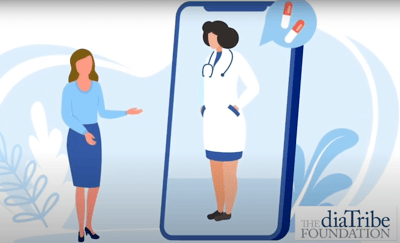Answering Common Questions about Telemedicine and COVID-19 with Andreina Millan-Ferro
By Matthew Garza
 By Matthew Garza
By Matthew Garza
Joslin Diabetes Center’s Andreina Millan-Ferro addresses many of the common questions people have about using telemedicine to connect with their healthcare team
As a result of the COVID-19 pandemic, medical appointments through video conferencing or phone calls are becoming more common for people managing their diabetes. These telemedicine appointments allow people to access many of the benefits of an in-person doctor’s visit from the comfort and safety of their own home while staying in line with social distancing guidelines. Telemedicine can save time and is often more convenient for people as opposed to regular office visits; it also provides people with increased access to care (and specialty care). One great thing about continuous glucose monitoring (CGM) is that it allows healthcare teams to understand a person’s diabetes management when they can’t see them in-person or give lab tests. By sharing your CGM data and discussing it with your healthcare professional during your virtual appointments, you can better understand your blood glucose patterns. Plus, it’s a great opportunity to look at your time in range (TIR). By watching how your TIR is impacted by what you eat, your exercise habits, or just your day-to-day activities, you can work with your healthcare team to build positive habits.
diaTribe is thrilled to partner with Andreina Millan-Ferro of the world-renowned Joslin Diabetes Center to spread more learning about telemedicine and the power of connection in healthcare. She addresses key questions such as: How do I prepare for my first telemedicine appointment? How do I know if it is covered by my insurance? What medication can be prescribed through telemedicine? She also speaks to her personal experiences using technology to access quality healthcare.
This 10-minute video covers the following sections:
-
00:10 Introduction: what is telemedicine?
-
01:05 Pros and cons of using telemedicine
-
03:29 How do I prepare for my first telemedicine appointment?
-
04:58 How do I know if my insurance covers telemedicine?
-
05:39 How do people pay for telemedicine appointments?
-
06:21 Can medications be prescribed using telemedicine?
-
07:38 Can I overcome barriers to telemedicine?
-
08:50 Andreina's personal experiences with telemedicine & the power of connection
-
10:15 Acknowledgements to The diaTribe Foundation
Telehealth can help people with diabetes access healthcare in a safer environment, but it is important to note that while there are many benefits to telemedicine, there are also some downsides. Telemedicine appointments require internet, smartphones and computers, and private and quiet spaces to meet, which are not readily available for every person. As telemedicine becomes more widespread, we must continue to make these services accessible for as many people as possible. You can join diaTribe Change in helping all people with diabetes access telehealth.
We encourage you to check out some of our other articles on telemedicine: Diabetes Care During COVID-19: The Power of Telemedicine and Top Nine Tips for Diving Into Telemedicine With Your Doctor During COVID-19.
This video was funded by a generous contribution from The Ella Fitzgerald Charitable Foundation.








